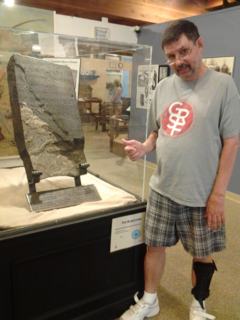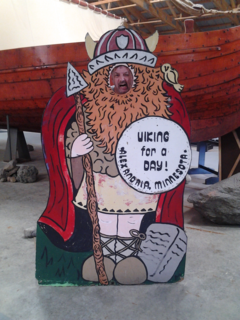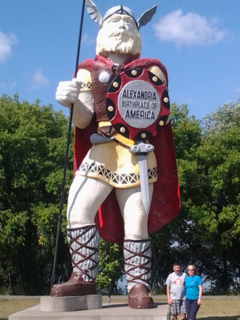The Birthplace of America?
August 16, 2013
 I have wanted to visit the Runestone Museum in Alexandria Minnesota since I moved to the state in 1995. It’s only a bit over two hours away from where I’ve lived all these 18 years, so I guess I really hadn’t made much of an effort. But circumstances a couple of weeks ago put me ten miles from its doorstep with plenty of free time, and I finally managed to see it.
I have wanted to visit the Runestone Museum in Alexandria Minnesota since I moved to the state in 1995. It’s only a bit over two hours away from where I’ve lived all these 18 years, so I guess I really hadn’t made much of an effort. But circumstances a couple of weeks ago put me ten miles from its doorstep with plenty of free time, and I finally managed to see it.
Those of you unfamiliar with the story of the Kensington Runestone (KRS) should see Wikipedia’s article on the subject, a fairly balanced and complete recounting of a fascinating story. In short, a Swedish-American farmer, Olaf Ohman, claimed to find the stone on his Minnesota farm in 1898. According to its inscription, it was created on the spot in 1362 by a small group of Viking explorers—well over 100 years before Columbus “discovered” the so-called “New World.”[1] More than 100 years after Ohman’s find, despite the fact that virtually all qualified researchers who have investigated the issue reject it as a forgery, true believers remain. Not least of all the curators of the Runestone Museum in Alexandria, Minnesota.
Here is a translation of the stone[2]:
Eight Götalanders and 22 Northmen on (this?) acquisition journey from Vinland far to the west. We had a camp by two (shelters?) one day’s journey north from this stone. We were fishing one day. After we came home, found 10 men red from blood and dead. Ave Maria save from evil. There are 10 men by the inland sea to look after our ships fourteen days journey from this peninsula (or island). Year 1362
Prior to this visit, I hadn’t read anything about the Runestone since 1997, when I read University of Minnesota professor Theodore C. Blegen’s 1968 book on the controversy, Kensington Rune Stone, New Light on an Old Riddle. At the time I read it it was still considered the definitive study on the issue. It seemed to be a closed case. A hoax, but a good one in many ways. Blegen flatly stated that Ohman was the forger, and offered evidence that he was intellectually and temperamentally capable of the act. But if the KRS hadn’t fooled many linguists and runeologists, it had certainly fooled many others, and had received attention from such august institutions as the Smithsonian and the National Geographic Society.
 (Blegen’s book and its indictment of Olaf Ohman notwithstanding, the best evidence against the the authenticity of the KRS was and continues to be linguistic.[3])
(Blegen’s book and its indictment of Olaf Ohman notwithstanding, the best evidence against the the authenticity of the KRS was and continues to be linguistic.[3])
Hoaxes of this magnitude never seem to die, however.
It turns out that there have been important developments in the story of which I was not aware. Even the academic community that continues to dismiss the stone as a fake concedes as much.
Chief among these developments was the discovery in 2004 of the 1883 notes of a 16-year-old Swedish boy, Edward Larsson, that validated some of the runes on the stone that had been dismissed by scholars as inventions of the forger. The inscription includes runes that prior to the Larsson find were unknown even to runic scholars. Surely this was proof that the KRS could not have been the work of a Swedish-Minnesotan farmer in the 1890s? However, the story is more complicated than that. It was subsequently learned that Larsson’s aunt and son migrated from Sweden to Crooked Lake, Minnesota—very near Alexandria—in 1870. And at any rate,  Larsson’s notes established only that runes for certain Latin alphabetic characters first known to be used in the 16th century (at least 200 years after the purported creation of the KRS) were known to some Swedes of the late 19th century. Including at least one with a connection to the area where the stone was found). Perhaps Ohman himself was fooled, and the forger is still at large (so to speak).
Larsson’s notes established only that runes for certain Latin alphabetic characters first known to be used in the 16th century (at least 200 years after the purported creation of the KRS) were known to some Swedes of the late 19th century. Including at least one with a connection to the area where the stone was found). Perhaps Ohman himself was fooled, and the forger is still at large (so to speak).
The town of Alexandria certainly embraces its Viking heritage, be it real or imagined. It styles itself “the Birthplace of America.” It is a fun story. The mystery of the KRS’s origin is no less interesting, to me at least, hoax or not. Kudos to the carver, whoever he may be.
—
Notes
- At the time Ohman made his claim, conventional opinion discounted the idea that the Vikings reached America before Columbus. This, of course, has changed. [^]
- Translation by Henrik Williams and Richard Nielsen. [^]
- Linguists qualified to have opinions on Old Swedish virtually unanimously reject the KRS’s text as a modern forgery. Most seem to be quite derisive in their opinions of it. One other strike against it should be mentioned. Shortly after Blegen’s book was published, The Minnesota Historical Society (MHS) released audiotapes of a neighbor of Ohman claiming his father admitted to him, when he thought he was dying, that he and Ohman forged the stone. The MHS continues to believe that this “confession” is the smoking gun that disproves the authenticity of the KRS. Not everyone, even those who believe the stone is a fake, accepts the validity of this second-hand confession. [^]
—
STILL MORE
The Runestone Museum’s bookstore contains several volumes on the subject of the KRS and, as you might expect, they all come down on the side of its authenticity. Most appear to me to be sensationalistic and of dubious merit. At least one posits the existence of secret messages encoded in the KRS’s text and, of course, involvement by the Knights Templar. I’m surprised that Dan Brown hasn’t yet written a sensational bestseller on the subject.
In a quick check of Amazon.com, I was unable to find any recent balanced, serious works on the subject. (Older, out-of-print editions are available at very high prices.)
One of the books available in the Museum’s bookstore is Richard Nielsen and Scott F. Wolter’s 574-page tome, published in 2006, The Kensington Rune Stone: Compelling New Evidence. They conclude, based on some geological tests and amateur sleuthing, that the stone is a genuine 14th-century Viking artifact. At some point these authors had a spectacular and entertaining fallout that reverberates on the Internet to this day. Olaf Ohman’s grandson Darwin Ohman sides with Wolter, while Nielsen—who may no longer support the stone’s authenticity and accuses the geologist Wolter of slipshod and/or dishonest work on the stone—is aligned with perhaps the preeminent linguist still engaged with the KRS, Henrik Williams. This selection of links is a rabbit hole that probably should be avoided, but what the heck …
Henrik Williams’s excellent essay from the Swedish-American Historical Quarterly is available in PDF format from Uppsala University: “The Kensington Runestone: Fact and Fiction”.
Wolter’s 2011 “Report of Digital Microscopic Examination” of the stone
Nielsen’s review of Wolter’s 2001 report Click on the “Discussion” link on Nielsen’s website, www.richardnielsen.org for virtual reams of papers on the subject of what Nielsen calls the “American Runestones.”
Darwin Ohman’s statements accusing Richard Nielsen of dishonesty and wrongdoings
Somewhat off the subject, but intriguing in its own right, is Jason Colavito’s exposure of Scott Wolter’s dishonest claim of a honorary Masters degree in geology from the University of Minnesota. Colavito also maintains a blog that challenges Wolter’s popular History Channel show, America Unearthed.
